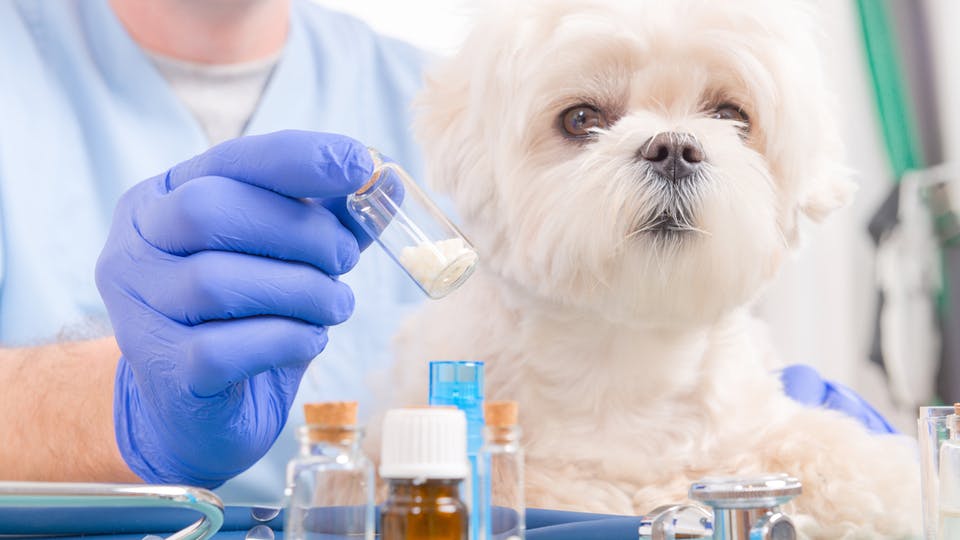If your pup is experiencing a high degree of discomfort, a veterinarian might suggest dog Tramadol to alleviate symptoms. Doctors often prescribe the same drug to human patients for pain management, but as a pet parent, it's critical that you know the difference between the two.
We'll go over these key details in the sections below to help you find the right pain relief for your dog that gets them feeling back on track.
- What is Tramadol?
- How does Tramadol work?
- What is Tramadol used for in dogs?
- Tramadol dosage for dogs
- Tramadol side effects in dogs
- Can your dog overdose on Tramadol?
- Are there any risk factors for Tramadol?
- Tramadol and other medications
- Key Takeaways
 (Image source: Care)
(Image source: Care)
What is Tramadol?
Tramadol is a drug approved to treat moderate to severe pain in dogs as well as humans. It's classified as an opioid analgesic, similar to morphine and fentanyl, meaning it directly alters the perception and transmission of pain by activating the body's opioid receptors in the nervous system.
Compared to a non-steroidal anti-inflammatory drug (NSAID) that you can buy over-the-counter (OTC) to relieve mild pain, such as Ibuprofen, the analgesia in Tramadol makes this opioid medication significantly stronger and potentially dangerous if taken incorrectly.
Pro tip: Pet insurance accident coverage can help you care for your canine companion if they get hurt without worrying about the cost. It covers emergency injuries related to accidents, such as abrasions, torn ligaments, broken bones, toxic ingestions, swallowed objects, and so forth. You never know what could happen, but a pet insurance policy means you'll know you're always prepared just in case.
How does Tramadol work?
The drug works with norepinephrine and serotonin reuptake inhibitors. Norepinephrine is essentially a fight-or-flight substance. After it leaves the brain, the chemical moves around the body picking up various signals from neuroreceptors, including pain.
Tramadol doesn’t target the area affected by pain directly, so it doesn't stimulate recovery in joint, bone, or muscle. Therefore, it's typically prescribed for acute pain relief during recovery, although some vets might recommend its ongoing use to alleviate chronic pain symptoms associated with conditions such as arthritis or kidney diseasae.
Typically, norepinephrine returns to the brain with the gathered information, but Tramadol blocks it, signaling to the brain to continue sending norepinephrine in small doses and help keep the body active through severe discomfort. In other words, Tramadol tricks the brain into believing that the pain is lower than it actually is.
High norepinephrine levels in the bloodstream will also signal the body to release serotonin, a neurological chemical that creates euphoric feelings. So, if you notice your pooch feeling a little loopy after taking Tramadol, it’s because the increase of serotonin and norepinephrine levels create a pain-free, euphoric feeling.
Dog Tramadol is one of the few drugs that share nearly the exact same chemical composition as a human medication. The pain meds your pup takes will be very similar to the ones you might have experience with at home, apart from minor alterations in their chemical structure to make them safer for the animal’s organs.
What is Tramadol used for in dogs?
Tramadol is used for a number of ailments in dogs, ranging from joint stiffness and arthritis to managing pain experienced after surgery. Some of the most common uses of the drug include:
- Postoperative pain
- Broken bones
- Sprained joints
- Osteoarthritis
- Degenerative joint disease
- Severe nerve pain
- Back pain
- Cancer
Other uses include treating:
- Coughing
- Anxiety
- Degenerative myelopathy (a disease affecting the spinal cord)
Tramadol dosage for dogs
Tramadol is a controlled substance and requires special paperwork for prescription filled for a veterinary patient. The pet's owner will also need to provide certain information (such as his or her date of birth) to be able to purchase Tramadol for dogs.
Your veterinarian will determine the correct dosage for your pet. Don’t attempt to calculate or alter the dosage prescribed to your furry companion without speaking to your vet first.
Vets calculate dosages based on the dog’s weight, as well as other factors, including any pre-existing conditions and the cause of the pain itself. So, for example, the dosage for chronic pain may differ from the dosage for acute pain. In addition, Tramadol dosages for dogs differ significantly from those for humans, so giving your pet Tramadol outside of the guidance of a vet can result in a tramadol overdose.
Oral Tramadol is given in the form of tablets, capsules at a very specific strength concentration, at very specific times depending on your dog's size and body weight. If you’re giving Tramadol pills, it’s best to cut them into small pieces for proper doses for very small dogs, but bear in mind that the pills have a bitter taste and might be rejected by some discerning dogs, especially if they're on the medicine for a while. Foods like peanut butter can be very helpful to mask the taste with a yummy treat.
Your vet could alternatively prescribe liquid Tramadol administered with food or without food, but if it it doesn't settle well with your poor guy or gal on an empty stomach, try giving the next dose with food. Liquid medication will require you to carefully measure the proper Tramadol dosage by the milliliter (mL).
Tramadol takes effect quickly, in about one or two hours, after which improvement in clinical signs should follow. In dogs with chronic pain, the drug can take up to several weeks before full effects are observed. Tramadol is a short-acting medication, which means that it usually stops working within 12 hours, even though its effects could be longer in dogs with kidney or liver disease.
If you accidentally skip a dose, resume the next dose according to schedule. Don’t give your pooch two doses at once.
Store the drug in a dark and dry place, at room temperature, and away from kids and other pets.
 (Image source: Dog Time)
(Image source: Dog Time)
Tramadol Side Effects in Dogs
Tramadol can be very helpful when it comes to managing pain in dogs, but it does come with some risks. Classified as a Schedule lV controlled substance, it is considered dangerous if administered incorrectly. For that reason, you should always follow your vet’s instructions when giving this drug to your pet.
Some of the most common side effects of Tramadol include:
- Vomiting
- Nausea
- Diarrhea
- Dizziness
- Dilated pupils
- Extreme sleepiness
- Panting
- Upset stomach
- Decreased appetite
- Decreased heart rate
- Increased heart rate
- Constipation
- Incoordination
- Agitation
Can Your Dog Overdose on Tramadol?
It is highly advised to use Tramadol with caution to avoid an overdose. The following symptoms might indicate a Tramadol overdose:
- Inability to stay awake
- Excessive drooling
- Uncontrolled movement
- Severely low heart rate
- Muscle spasms
- Aggressive behavior
- Slow, shallow breath
- Seizures
- Tremors
- Coma
If you fear your dog has a Tramadol overdose or an adverse reaction of any kind, contact your vet right away.
Pro tip: Remember, there are many toxic substances toxic lying around the home, including potent medication. Unfortunately, accidental poisonings are one of the most common pet insurance claims for dogs, so consider saving yourself the stress and money with a protection plan in advance.
Are there risks for giving a dog Tramadol?
Tramadol should not be used in dogs who are hypersensitive to opioids and exercise caution in pets with kidney or liver disease, seizure disorders, and in pregnant, nursing, geriatric, oe debilitated animals. Don’t use dog Tramadol with other sedatives that decrease lung or brain function.
Tramadol and other medications
Tramadol is compatible with all the COX-inhibiting NSAIDs, as well as nutraceuticals for joint pain like MSM, glucosamine, and chondroitin sulfate.
However, there are many medications that cannot be combined with Tramadol:
-
The drug is not compatible with Deprenyl. Pets taking Deprenyl for senility or Cushing’s Syndrome must not take narcotic drugs like Tramadol.
-
When combined with amitraz, the active ingredient present in some tick control products, Tramadol can induce sedation.
-
Tramadol is also not compatible with other psychoactive drugs like tricyclic antidepressants, monoamine oxidase inhibitors, or serotonin reuptake inhibitors.
-
If used in conjunction with antihistamines, Tramadol can make sedation side effects worse.
-
In addition, this pain-reliever drug might not be compatible with the joint and liver support nutraceutical SAMe.
-
If Tramadol is used together with the appetite stimulant drug cyproheptadine, the effect of the Tramadol could be reduced.
-
If used together with benzodiazepine antianxiety medications, Tramadol increases the risk of respiratory depression.
-
The risk of tramadol toxicity is increased if the pain-killer is used together with erythromycin, cimetidine, and metoclopramide.
Be sure to inform your vet if your dog is taking any medications, including supplements, vitamins, and herbal therapies.
Final thoughts
Tramadol can be an excellent resource in your pet’s recovery process for post-operative pain or acute pain, but it should still be taken with caution.
The drug might take up to 2 weeks to have an effect for chronic pain and it might cause changes in behavior or alertness.
Tramadol is a controlled substance in the States, which means it is against the law to use, sell, or give away this drug to others than for whom it was prescribed.
Whenever you give your pup a new drug, keep an eye on them to see how they respond and contact your vet if you notice anything out of the ordinary.
Key Takeaways
- Dog Tramadol is an opioid drug used to alleviate moderate to severe pain in canines.
- It has a similar effect as it does in humans, but the Tramadol dosage for dogs is much smaller and determined very carefully by a veterinarian based on weight, size, and health history.
- Never give your dog Tramadol without first consulting your vet and always watch for signs of an adverse reaction when administering the medication.
